
Castlefield is an inner-city conservation area in Manchester, North West England. The conservation area which bears its name is bounded by the River Irwell, Quay Street, Deansgate and Chester Road. It was the site of the Roman era fort of Mamucium or Mancunium which gave its name to Manchester. It was the terminus of the Bridgewater Canal, the world's first industrial canal, built in 1764; the oldest canal warehouse opened in 1779. The world's first passenger railway terminated here in 1830, at Liverpool Road railway station and the first railway warehouse opened here in 1831.

Crumpsall is an outer suburb and electoral ward of Manchester, England, 3 miles (5 km) north of Manchester city centre, bordered by Cheetham Hill, Blackley, Harpurhey, Broughton, and Prestwich. The population at the 2011 census was 15,959. Historically part of Lancashire, Crumpsall was a township within the parish of Manchester, Salford Hundred. North Manchester General Hospital is in Crumpsall.

Manchester City Centre is the central business district of Manchester, England, within the confines of Great Ancoats Street, A6042 Trinity Way, and A57(M) Mancunian Way, which collectively form an inner ring road. The City Centre ward had a population of 17,861 at the 2011 census.

Prestwich is a town in the Metropolitan Borough of Bury, Greater Manchester, England, 3 miles (4.8 km) north of Manchester, 3 miles (5 km) north of Salford and 5 miles (8.0 km) south of Bury.

Cheetham is an inner-city area and electoral ward of Manchester, England, which in 2011 had a population of 22,562. It lies on the west bank of the River Irk, 1.4 miles (2.3 km) north of Manchester city centre, close to the boundary with Salford, bounded by Broughton to the north, Harpurhey to the east, and Piccadilly and Deansgate to the south.
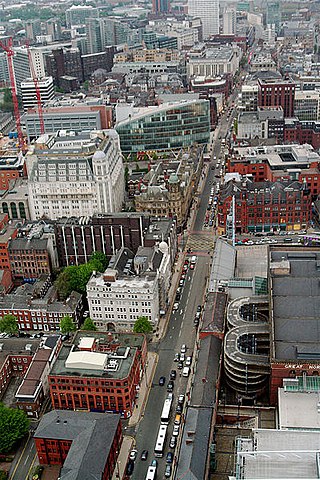
Deansgate is a main road through Manchester City Centre, England. It runs roughly north–south in a near straight route through the western part of the city centre and is the longest road in the city centre at over one mile in length.
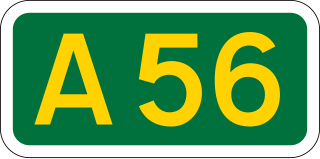
The A56 is a road in England which extends between the city of Chester in Cheshire and the village of Broughton in North Yorkshire. The road contains a mixture of single and dual carriageway sections, and traverses environments as diverse as the dense urban sprawl of inner city Manchester and the lightly populated region of rural east Lancashire. The road includes a short section of trunk road between the end of the M66 motorway near Ramsbottom and the M65 motorway west of Burnley.

Broughton is a suburb and district of Salford, Greater Manchester, England. Located on the east bank of the River Irwell, it is 1 mile (1.6 km) northwest of Manchester and 2 miles (3.2 km) south of Prestwich.

Crumpsall Park is a small municipal park in the Crumpsall ward of Manchester, North West England.

Woodlands Road was a tram stop on the Bury Line of the Metrolink system in the Cheetham Hill area of north Manchester, England. It opened in 1913 as a heavy rail station and closed for conversion to light rail in 1991, opening with the new Metrolink system in 1992.

The architecture of Manchester demonstrates a rich variety of architectural styles. The city is a product of the Industrial Revolution and is known as the first modern, industrial city. Manchester is noted for its warehouses, railway viaducts, cotton mills and canals – remnants of its past when the city produced and traded goods. Manchester has minimal Georgian or medieval architecture to speak of and consequently has a vast array of 19th and early 20th-century architecture styles; examples include Palazzo, Neo-Gothic, Venetian Gothic, Edwardian baroque, Art Nouveau, Art Deco and the Neo-Classical.

The Museum of Transport, Greater Manchester aims to preserve and promote the public transport heritage of Greater Manchester in North West England. It is located in the Cheetham Hill area of Manchester.
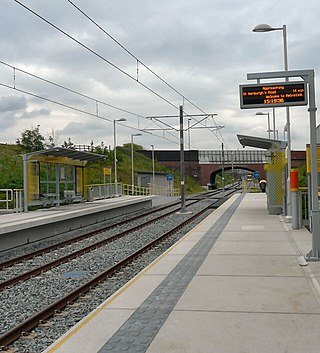
Monsall is a tram stop on the Oldham and Rochdale Line (ORL) of Greater Manchester's light-rail Metrolink system in the Monsall area of Manchester in North West England. The Oldham and Rochdale line was built as part of Phase 3a of the system's expansion, on most of the route of the former Oldham Loop Line, and opened to passengers on 13 June 2012.
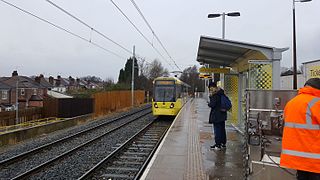
Abraham Moss is a tram stop in the suburban area of Cheetham Hill, Greater Manchester, England. It is on the Bury Line of Greater Manchester's light rail Metrolink system. The station gained funding approval in 2010 and replaced nearby Woodlands Road stop. It is close to the local library and college campus. The planning application for the station was lodged June 2010. Construction began on 18 October 2010 and the station became operational on 18 April 2011.

The Manchester Reform Synagogue is a Reform Jewish congregation based in Central Manchester, England, in the United Kingdom. The congregation, founded in 1857 as the Manchester Congregation of British Jews, is one of the oldest Reform communities in the United Kingdom, and is a member of the Movement for Reform Judaism.
By the end of 18th century, the rapidly growing town of Manchester, England, had a small Jewish community, some of whose members had set up businesses, and a place of worship. The history of Manchester's Jewish community is told at the Manchester Jewish Museum in Cheetham. The Jewish community in Manchester is the second largest in Britain; the first being in Greater London.

The Bury Line is a light rail/tram line on the Manchester Metrolink in Greater Manchester. It runs from Manchester Victoria station to Bury Interchange in the north. The entire line runs along a converted heavy rail line, and was reopened with the Altrincham Line, another Metrolink line converted from heavy rail, as part of Phase 1 of the Metrolink's expansion.
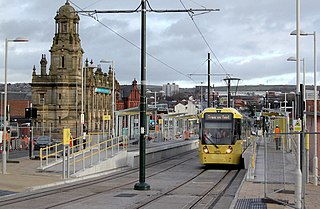
The Oldham and Rochdale Line (ORL) is a light rail/tram line on the Manchester Metrolink in Greater Manchester, running from North Manchester to Rochdale town centre via Oldham, reusing most of the trackbed of the former Oldham Loop railway line which closed in 2009. The line was re-opened in a modified form as a tramway from 2012 – 2014, as part of Phase 3 of the Metrolink's expansion.

Smedley is an area of north Manchester, England, on the banks of the River Irk between Cheetham Hill to the west, Collyhurst to the south, Crumpsall to the north and Harpurhey to the east.


















